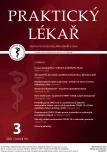Our experience with the use of NPWT methods and their availability
Authors:
E. Šimůnková; K. Chrz; E. Konečná; D. Michalský; L. Dolejší; M. Zeman
Authors‘ workplace:
I. chirurgická klinika 1. lékařské fakulty Univerzity Karlovy a Všeobecné fakultní nemocnice, Praha, Přednosta: prof. MUDr. Zdeněk Krška, DrSc.
Published in:
Prakt. Lék. 2021; 101(3): 152-159
Category:
Of different specialties
Overview
At present NPWT is helpful in treatment of chronic wounds. Based on our own experience, we have assessed the usability of individual methods simultaneously with their availability in the clinical and outpatient practice.
Keywords:
NPWT – negative pressure therapy – chronic wound
Sources
1. Dumville JC, Owens GL, Crosbie EJ, et al. Negative pressure wound therapy for treating surgical wounds healing by secondary intention. Cochrane Database Syst Rev 2015; 6: CD0011278.
2. Hampton J. Providing cost - effective treatment of hard to heal wounds in the community through use of NPWT. Br J Community Nurs 2015; 20(Suppl 6): S14–S20.
3. Bobkiewicz A, Bansievicz T, Ledwonsinski W, Drews M. Medical terminology associated with negative pressure wound therapy (NPWT) Understanding an misunderstanding in the field of NPWT. NPWTJ 2014; 1(2): 69–73.
4. Chariker ME, Jeter KF, Tintle TE, Bittsford JE. Effective management of incisional and cutaneous fistulae with closed suction and wound drainage. Contemp Surg 1989; 34 : 59–63.
5. Huang S, Ingber DE. The structural and mechanical complexity of cell growth control. Nat Cell Biol 1999; 1: E131–E138.
6. Lohman RF, Lee RC. Discussion: vacuum assisted closure microdeformations of wound and cell proliferation. Plast Reconstr Surg 2004; 114(5): 1097–1098.
7. Kreis BE, de Mol van Oterloo JC, Kreis RW. Open abdomen management a review of its history and a proposed management algorithm Med Sci Monit 2013; 19 : 524–533.
8. de Waele JJ, Kaplan M, Sugrue M, et al. How to deal with an open abdomen? Anesthesiol Intensive Ther 2015; 47 : 372–378.
9. Chen SZ, Li J, Li XY, Xu LS. Effects of vakuum asisted closure on wound microcirculation an experimental study Asian J Surg 2005; 28(3): 211–217.
10. Fleischmann W, Russ M, Westhauser A, Stampehl M. Vacuum sealing as carrier system for controlled local drug administrationin wound infection. Unfallchirurg 1998; 101(8): 649–654.
11. Muller G. Vacuum dressing in septic wound treatment. Langenbeks Arch Chir Suppl Kongressbd 1997; 114 : 537–541.
12. Kim PJ, Attinger CE, Crist BD, et al. Negative pressure wound therapy with instilation: review of evidence and recommendations. Wounds 2015; 27(12): S12–19.
13. Fluieraru S, Bekara F, Naud M, et al. Sterile-water negative pressure instilation therapy for complex wounds and NPWT failures. J Wound Care 2013; 22(6): 293–299.
14. Fleischmann W, Lang E, Russ M. Treatment of infection by vaccum sealing. Unafallchirurg 1997; 101(4): 649–654.
15. Gupta S, Gabriel A, Lantis J, Teot L. Clinical recommendations and practical guide for negative pressure wound therapy with instillation. Int Wound J 2016; 13(2): 159–174.
16. Apelquist J, Willy C, Fagerdahl AM, et al. Negative pressure wound therapy-overwiew, challenges and perspectives. J Wound Care 2017; 26(Suppl 3): S1–S154.
17. Wilkes RP, Kilpad DV, Zhao Y, et al. Closed incision management with negative pressure wound therapy (CIM): biomechanics. Surg Innov 2012; 19(1): 67–75.
18. Meeker J, Weinhold P, Dahners L. Negative pressure therapy on primarily closed wounds improves wound healing parameters at 3 days in a porcine model. J Ortop Trauma 2011; 25(12): 756–761.
19. Collier M. Topical negative pressure therapy. Nurs Times 2003; 99(5): 54–55.
20. Guy H, Grothier L. Using negative pressure therapy in wound healing. Nurs Times 2012; 108(36): 16–20.
21. Henderson W, Timmons J, Hurd T, et al. NPWT in everyday practice made easy. Wound Int 2010; 1(5): 1–6.
22. Malmsjö M, Huddleston E, Martin R. Biological effects of disposable canisterless negative pressure wound therapy system. Eplasty 2014; 14: e15.
23. Ousey KJ, Milne J. Exploring portable negative pressure wound therapy devices in community. Br J Community Nurs 2014; Suppl: S14–20.
24. Hisket G. Clinical and econonomic consequences of discharge from hospital with on-going TNP therapy: a pilot study. J Tissue Viability 2010; 19(1): 16–21.
25. Anthony H. Efficiency and cost effectivenes sof negative pressure wound therapy. Nurs Stand 2015; 30(8): 64–70.
26. Searle R, Milne J. Tools to compare the cost of NPWT with advanced wound care an aid to clinical decision making. Wounds UK 2010; 6(1): 106–109.
27. Lewis LS, Convery PA, Bolac CS, et al. Cost of care using prophylactic negative pressure wound vacuum on closed laparotomy incisions. Gynecol Oncol 2014; 132(3): 684–689.
28. Ministerstvo zdravotnictví České Republiky. Vyhláška č. 268/2019 Sb. o stanovení hodnot bodu, výše úhrad hrazených služeb a regulačních omezení pro rok 2020.
29. Flack S, Apequist J, Keith M, et al. An economic evaluation of VAC therapy compared with wound dressing in the treatment of diabetic foot ulcers. J Wound Care 2008; 17(2): 71–78.
30. Bartkowski R. Length of hospital stay due to DRG reimbursement. Ther Umsch 2012; 69(1): 15–21.
31. Verhaalen A, Watkins B, Brasel K. Techniques and cost effectiveness in enteroatmospheric fistula isolation. Wounds 2010; 22(8): 212–217.
Labels
General practitioner for children and adolescents General practitioner for adultsArticle was published in
General Practitioner

2021 Issue 3
Most read in this issue
- How to (correctly) process and publish case report from clinical practice?
- Our experience with the use of NPWT methods and their availability
- Lingua geographica in the general practitioner’s surgery
- Clinical course of COVID-19 in a high-risk patient
